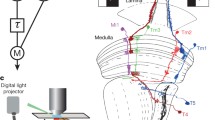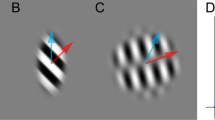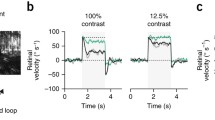Abstract
Global motion perception is important for mobile organisms. In laterally eyed birds, global motion appears to be processed in the entopallium, a neural structure that is part of the tectofugal pathway. Electrophysiological research has shown that motion selective cells in the entopallium are most responsive to small dark moving targets. Here, we investigated whether this bias toward dark targets of entopallial cells is mirrored by perceptual performance in a motion detection task in pigeons. We measured the detection thresholds of pigeons using random dot stimuli that consisted of either black or white dots on a gray background. We found that thresholds were significantly lower when using black dots as opposed to white dots. This heightened sensitivity is also noted in the learning rates of the pigeons. That is, we found that the pigeons learned the detection task significantly faster when the stimuli consisted of black dots. We believe that our results have important implications for the understanding of the functional role of the entopallium and the ON and OFF pathways in the avian motion system.



Similar content being viewed by others
References
Balasubramanian V, Sterling P (2009) Receptive fields and functional architecture in the retina. J Physiol 587:2753–2767
Baron J, Pinto L, Dias MO, Lima B, Neuenschwander S (2007) Directional responses of visual wulst neurones to grating and plaid patterns in the awake owl. Eur J Neurosci 26:1950–1968
Bischof WE, Reid SL, Wylie DR, Spetch ML (1999) Perception of coherent motion in random dot displays by pigeons and humans. Percept Psychophys 61:1089–1101
Burr D, Thompson P (2011) Motion psychophysics: 1985–2010. Vision Res 51(1431):1456
Cook RG, Katz JS (1999) Dynamic object perception by pigeons. J Exp Psychol Anim Behav Proc 25:194–210
Cook RG, Murphy MS (2012) Avian visual processing of motion and objects. In: Lazareva OF, Shimizu T, Wasserman EA (eds) How animals see the world: behavior, biology, and evolution of vision. Oxford University Press, London, pp 271–288
Dittrich WH, Lea SE, Barrett J, Gurr PR (1998) Categorization of natural movements by pigeons: Visual concept discrimination and biological motion. J Exp Anal Behav 70:281–299
Edwards M, Badcock DR (1994) Global motion perception: interaction of the ON and OFF pathways. Vis res 34:2849–2858
Engelage J, Bischof HJ (1993) The organization of the tectofugal pathway in birds: a comparative review. In: Zeigler HP, Bischof HJ (eds) Vision, brain, and behavior in birds. MIT Press, Cambridge, pp 137–158
Fu YX, Xiao Q, Gao HF, Wang SR (1998) Stimulus features eliciting visual responses from neurons in the nucleus lentiformis mesencephali in pigeons. Vis Neurosci 15:1079–1087
Gu Y, Wang Y, Zhang T, Wang SR (2002) Stimulus size selectivity and receptive field organization of ectostriatal neurons in the pigeon. J Comp Physiol A 188:173–178
Hendricks J (1966) Flickerthresholds as determined by a modified conditioned suppression procedure. J Exp Anal Behav 9:501–506
Jarvis JR, Taylor NR, Prescott NB, Meeks I, Wathes CM (2002) Measuring and modelling the photopic flicker sensitivity of the chicken (Gallus g. domesticus). Vision Res 42:99–106
Jin J, Wang Y, Lashgari R, Swadlow HA, Alonso JM (2011) Faster thalamocortical processing for dark than light visual targets. J Neurosci 31:17471–17479
Karten HJ, Hodos W (1970) Telencephalic projections of the nucleus rotundus in the pigeon (Columba livia). J Comp Neurol 140:35–51
Karten HJ, Revzin AM (1966) The afferent connections of the nucleus rotundus in the pigeon. Brain Res 2:368–377
Köhler W (1940) Dynamics in psychology. Liveright Publishing Corp, New York
Komban SJ, Alonso JM, Zaidi Q (2011) Darks are processed faster than lights. J Neurosci 31:8654–8658
Lazareva OF, Shimizu T, Wasserman EA (2012) How animals see the world: behavior, biology, and evolution of vision. Oxford University Press, London
Lu ZL, Sperling G (2012) Black–white asymmetry in visual perception. J Vis 12:8
Morrone MC, Burr DC, Vaina LM (1995) Two stages of visual processing for radial and circular motion. Nature 376:507
Morrone MC, Burr DC, Di Pietro S, Stefanelli MA (1999) Cardinal directions for visual optic flow. Curr Biol 9:763–766
Nakayama K (1985) Biological image motion processing: a review. Vision Res 25:625–660
Nankoo J-F, Madan CR, Spetch ML, Wylie DR (2014) Perception of complex motion in humans and pigeons (Columba livia). Exp Brain Res 232:1843–1853
Nelder JA, Mead R (1965) A simplex method for function minimization. Comput J 7:308–313
Nguyen AP, Spetch ML, Crowder NA, Winship IR, Hurd PL, Wylie DR (2004) A dissociation of motion and spatial-pattern vision in the avian telencephalon: implications for the evolution of “visual streams”. J Neurosci 24:4962–4970
Nishida SY (2011) Advancement of motion psychophysics: review 2001–2010. J Vis 11:11
Ratliff CP, Borghuis BG, Kao YH, Sterling P, Balasubramanian V (2010) Retina is structured to process an excess of darkness in natural scenes. Proc Natl Acad Sci USA 107:17368–17373
Reymond L (1985) Spatial visual acuity of the eagle Aquila audax: a behavioural, optical and anatomical investigation. Vision Res 25:1477–1491
Rubene D, Håstad O, Tauson R, Wall H, Ödeen A (2010) The presence of UV wavelengths improves the temporal resolution of the avian visual system. J Exp Biol 213:3357–3363
Scase MO, Braddick OJ, Raymond JE (1996) What is noise for the motion system? Vision Res 36:2579–2586
Schiller PH (1995) The ON and OFF channels of the mammalian visual system. Prog Retin Eye Res 15:173–195
Shimizu T, Watanabe S (2012) The avian visual system: overview. In: Lazareva OF, Shimizu T, Wasserman EA (eds) How animals see the world: behavior, biology, and evolution of vision. Oxford University Press, London, pp 473–482
Spetch ML, Friedman A, Vuong QC (2006) Dynamic object recognition in pigeons and humans. Learn Behav 34:215–228
Wang Y, Gu Y, Wang SR (2000) Feature detection of visual neurons in the nucleus of the basal optic root in pigeons. Brain Res Bull 15:165–169
Weibull W (1951) A statistical distribution function of wide applicability. J Appl Mech 13:293–297
Xing D, Yeh CI, Shapley RM (2010) Generation of black-dominant responses in V1 cortex. J Neurosci 30:13504–13512
Yang J, Li X, Wang SR (2002) Receptive field organization and response properties of visual neurons in the pigeon nucleus semilunaris. Neurosci Lett 331:179–182
Acknowledgments
We would like to thank Isaac Lank, Jeffrey Pisklak and Jason Long for their help with technical issues and for running the pigeons in the experiments. This research was supported by Grants from the National Science and Engineering Research Council (NSERC) of Canada to M. L. S. and D. R. W.
Author information
Authors and Affiliations
Corresponding author
Electronic supplementary material
Below is the link to the electronic supplementary material.
Rights and permissions
About this article
Cite this article
Nankoo, JF., Madan, C.R., Spetch, M.L. et al. Sensitivity of the avian motion system to light and dark stimuli. Exp Brain Res 235, 401–406 (2017). https://doi.org/10.1007/s00221-016-4786-2
Received:
Accepted:
Published:
Issue Date:
DOI: https://doi.org/10.1007/s00221-016-4786-2




